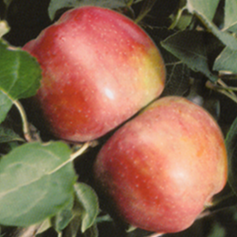Apple, Anna
Apple, Anna
Anna Apple (Malus domestica 'Anna') is a cultivar specifically bred to flourish in warmer climates. It is prized for its early-ripening, sweet, and crisp apples. The fruit has a red blush over a yellow-green background and is great for fresh eating, cooking, and baking.
Growing Zones: Suitable for USDA hardiness zones 5-9. This cultivar is especially well-suited for regions with mild winters and hot summers, such as the southern United States and coastal areas of California.
Height and Width
Height: Anna Apple (Malus domestica 'Anna') grows to a height of 10-20 feet (3-6 meters).
Width: Anna Apple (Malus domestica 'Anna') grows to a width of 10-20 feet (3-6 meters).
Uses
Fresh Eating: Anna Apple (Malus domestica 'Anna') are sweet, crisp, and excellent for fresh consumption.
Culinary: Good for baking, making pies, and cooking. The apples hold their shape well when cooked.
Pollinator: Anna apples are often planted with another low-chill apple variety, such as 'Dorset Golden,' for cross-pollination and improved yield.
Native Range
Anna apples are not native to any region; they are a cultivated variety developed in Israel for hot climates. They perform exceptionally well in areas with similar climate conditions.
Planting and Care
1. Site Selection: Choose a location with full sun for at least 6-8 hours per day. Ensure the site has good air circulation to reduce the risk of disease.
2. Soil: Prefers well-draining soil with a pH of 6.0-7.0. Amend heavy clay or sandy soils with organic matter to improve fertility and drainage.
3. Watering: Water young trees regularly to establish roots. Once established, water deeply and less frequently, especially during dry periods.
4. Fertilization: Feed with a balanced fertilizer in early spring before new growth begins. Additional feeding during the growing season may be beneficial.
5. Pruning: Prune in late winter to early spring while the tree is dormant. Remove dead, diseased, or crossing branches to promote good structure and airflow.
6. Mulching: Apply a 2-3 inch layer of mulch around the base of the tree to conserve moisture, regulate soil temperature, and suppress weeds.
Pests and Diseases
Pests: Watch for common apple pests such as aphids, apple maggots, and codling moths. Use appropriate pest control methods, including organic options like neem oil.
Diseases: Be vigilant for signs of apple scab, powdery mildew, and fire blight. Ensure good air circulation and avoid overhead watering to reduce disease risk.
Pollination
Pollination: Anna apple trees require cross-pollination from another apple variety that blooms at the same time. 'Dorset Golden' is a popular choice for this purpose.
Additional Tips
Thinning: Thin the fruit in early summer to prevent branches from breaking under the weight of too many apples and to improve the size and quality of the remaining fruit.
Harvesting: Anna apples are typically ready for harvest in early summer. The exact timing can vary depending on the local climate.
---SHIPPING NOTICE PLEASE READ BEFORE PURCHASING LIVE PLANTS!---
We WILL NOT refund the purchase of or the shipping cost of live plants purchased with the intent to be shipped to states that do not authorize importing live plants or to states with restrictions! Purchases to these states will be held for 30 days for pick-up at our Slidell, Louisiana store and the shipping cost associated with these purchases will be held for the care of the plant while waiting to be picked up. All sales are final. If the plant(s) purchased are not picked up within 30 days from the date of order, these items will be returned to our sales inventory and you WILL NOT be refunded. Thank you for understanding these policies.
Due to regulations, certain states have restrictions on importing plants. Please review the list below to ensure you're not attempting to order any restricted plants in your area.
**Important Note:** We do not ship any plants outside the U.S.
State-Specific Restrictions - We ARE NOT responsible for any plant(s) that are not listed in these restrictions. Purchaser bears all responsibility for making sure the plant(s) they desire to purchase are not banned from being imported to the shipping state:
Arizona: Juglans spp.
California: Castanea spp., Juglans spp., Pinus spp., Quercus spp.
Colorado: Some counties restrict Prunus spp. Please verify your local county regulations.
Florida: Castanea spp., Cornus spp., Quercus spp., Cornus mas
Georgia: Vaccinium spp.
Hawaii: Pinus spp.
Idaho: Humulus lupulus, Mentha spp., Vitis spp.
Indiana: Fragraria spp., Rosa spp.
Kansas: Juglans spp.
Michigan: Abies spp., Vaccinium spp.
Montana: Pinus spp.
Nevada: Allium spp.
Mentha spp.
New Jersey: Rosa spp.
New York: Vitis spp.
Oregon: Allium spp., Castanea spp., Corylus spp., Humulus lupulus, Quercus spp., Sambucus nigra, Ulmus spp., Vaccinium spp., Vitis spp.
Texas: Juglans spp.
Washington: Allium spp., Castanea spp., Corylus spp., Humulus lupulus, Vaccinium spp., Vitis spp.
Wisconsin: Abies spp., Pinus spp., Picea spp., Mentha spp.
Additionally, we cannot ship plants in soil medium to the following states: AK, AL, AR, AZ, CA, HI, ID, KS, MS, MT, ND, NM, NV, OK, OR, SD, TX, UT, WA.
Couldn't load pickup availability


